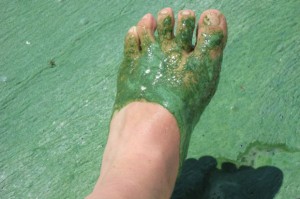
Few Oklahoma Cities Filter Water for Element That Causes Toxic Algae in Lakes
-
Logan Layden
There’s too much phosphorous in the vast majority of Oklahoma’s lakes and streams.
Excessive phosphorous and nitrogen leads to blue-green algae blooms, which can cause respiratory, eye, and stomach problems in people, and fish kills due to lack of oxygen.
The Journal Record‘s M. Scott Carter looked at recent reports from the Oklahoma Water Resources Board and the U.S. Environmental Protection Agency and found…
Seventy-one percent of Oklahoma’s lakes have high to excessive levels of the nutrients that spawn blue-green algae blooms. But only a handful of communities work to remove phosphorous — the primary culprit for the algae — from wastewater before it’s pumped back into the watershed.
And it’s not just an Oklahoma problem:
Documents from the EPA echo the state’s report. In a 2011 memo, the agency reported that 50 percent of U.S. streams had medium to high levels of nitrogen and phosphorous, while 78 percent of assessed coastal waters had eutrophication.
“Algae blooms are on steadily on the rise,” the EPA reported. “And related toxins have potentially serious health and ecological effects.
Only a small number of cities and towns currently specifically treat wastewater for phosphorous, but OWRB Executive Director J.D. Strong told The Journal Record all treatment facilities remove some phosphorous, and the trend is toward more.
Still, Strong says “phosphorous is one of the biggest issues in water quality impairment in the state.”
Strong said the OWRB has long been an advocate of controlling the element. … Treating wastewater is one way to reduce phosphorous, he said, but other sources — such as agricultural and urban sources — should also be addressed. Commercial fertilizer, poultry litter and runoff from the fertilizer used for household lawns add large amounts of phosphorous to wastewater, Strong said.

